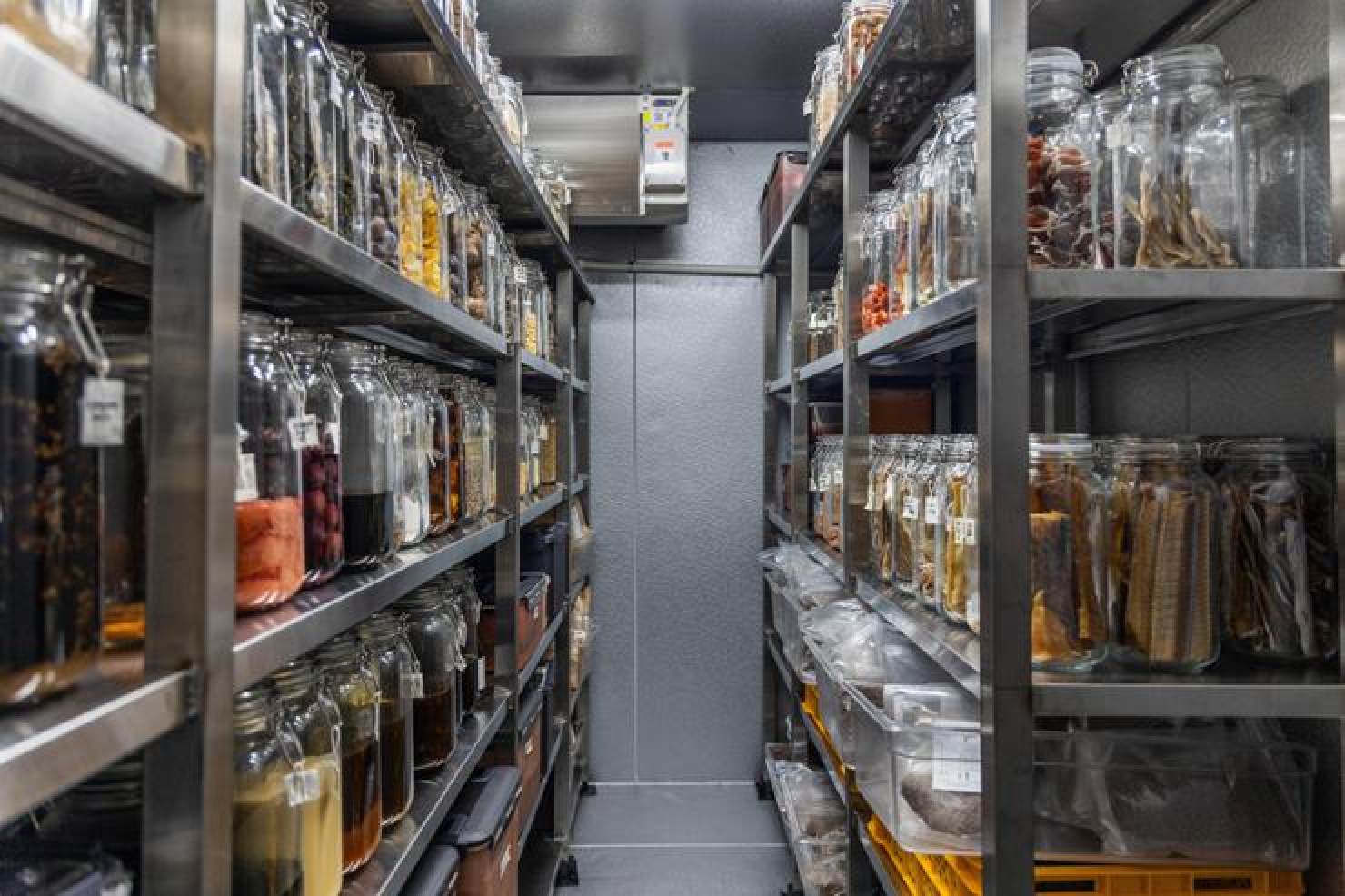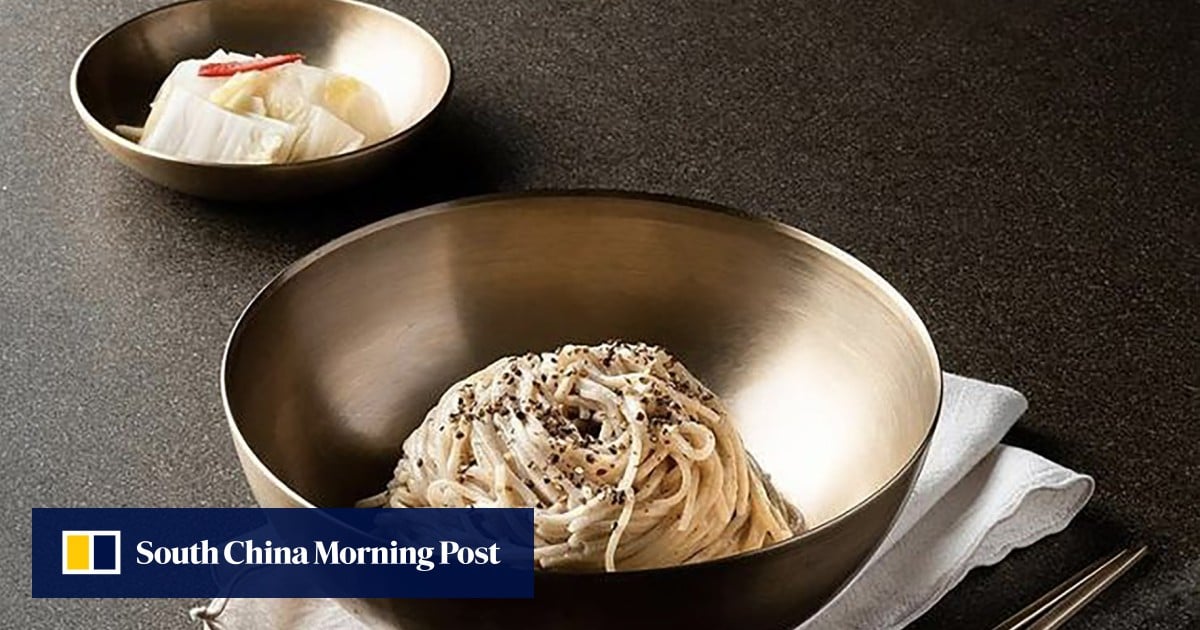By Park Jin-hai
Chef Kim Do-yun of one-Michelin-star restaurant Yun Seoul, known for his expertise in noodles and dedication to sourcing ingredients, is proud of being a “weirdo obsessed with ingredients” – a quirky label given to him by his customers.
In his restaurant, Kim has a lab-like refrigerated storage space where he keeps over 500 ingredients, labelled by year of production and place of origin – various pickles, dried vegetables, beans, grains, seeds, dried meat and dried fish, some of which have been aged up to seven years.
His collection of seeds alone includes some 90 different kinds of sesame and perilla seeds.
Kim says each ingredient, gathered from around the world and across South Korea, is like a book in a library. “I try to keep some ingredients produced [from a year] to study. I compare gosari (bracken fern) produced and dried seven years ago to that of this year and examine how its texture and taste became different,” Kim says.
“There were incidents [where] my staff mistakenly used up some ingredients produced in a certain year. It was the same pain that a book collector would feel when one’s rare, invaluable books are missing.”
Next time you’re in Seoul: 6 top Asian chefs share their go-to restaurants
Next time you’re in Seoul: 6 top Asian chefs share their go-to restaurants
Kim has put the most effort into the wheat samples that he has collected from his travels across France, Turkey, Italy and various Korean provinces, as they are key to his noodles.
“Since Korea has unfavourable environmental conditions to produce wheat, I had a hard time to find the right wheat that I can use for my noodles,” he says.
Yun Seoul, which earned a Michelin star in 2022 and still maintains that accolade, offers various cold and hot home-made Korean wheat noodles, house-aged fish dishes as well as umami-rich Korean beef dishes.

Kim attributes his fascination with noodles to a quest for creating additive-free varieties that preserve a natural fragrance, exemplified in his renowned nutty-flavoured perilla oil noodles.
“I spent over 17 years of my 30-year career dedicated to noodles. Most of the Korean noodles of today use mass-produced imported flours and thus cannot have aroma and contain additives.
“Noodles with additives can be chewy, but they are hard to digest. Modern people’s stomach ulcers are caused by these additives.
“I wanted to change this in the Korean culinary scene by making healthy noodles containing no additives but with the same chewy texture.”
How Korean blood sausage went from street food to hip fine-dining dish
How Korean blood sausage went from street food to hip fine-dining dish
Kim has meticulously developed a recipe where the noodles are the star of the show, not the toppings. To create the right fragrance, the chef roasts soybeans and mung beans and then combines them with whole-wheat flour.
“I dry ingredients and make my own broth from scratch. That may be time-consuming and not so profitable, but I think all chefs should at least try to find their own unique flavours without relying on MSG or concentrated flavouring,” he says, stressing that the key to completing a dish is the “scent” and that a good aroma comes from the ingredients.
The self-taught chef has had hands-on experience working for various Japanese, Italian and French restaurants in Korea since 1992.
“Quality in fine dining takes time. Rushing the process simply doesn’t cut it. Slow dry-ageing builds a depth of flavour you won’t find elsewhere.
“This philosophy of patience extends to my cooking style. Gosari dried fast using a dehydrator cannot have the same taste and texture from [gosari being] slowly dried.”
‘No way you leave without having good seafood’: why Busan is the best
‘No way you leave without having good seafood’: why Busan is the best
In the next five years, Kim plans to build a research lab and museum showcasing various Korean food ingredients.
“I want to showcase the history of Korean food ingredients and demonstrate the diversity of Korean cuisine.”
Kim urges aspiring chefs to approach food with a sense of authenticity and deep understanding of where it comes from. “A cook who only tries to cook modern Korean food with superficial knowledge and thinks of making it short should not even think of being a cook as a profession.
“In my twenties, I arrogantly thought that I was the best when it comes to cooking and that I had nothing more to learn, but in my thirties, I realised that learning for a cook is endless,” he says.
“When using ingredients, they should understand how the ingredients came to be and be grateful to the people who grew them. When using beef, they should know what kind of feed the cow was given and how that feed affects the quality of the meat.”







